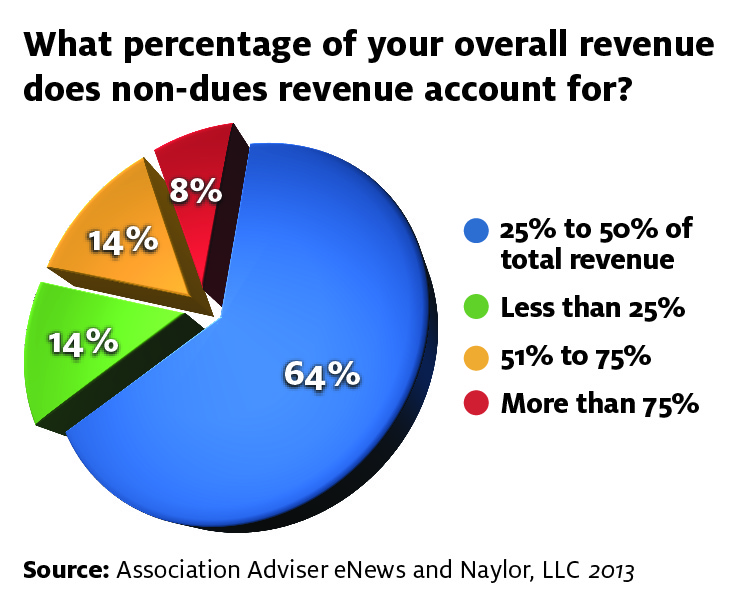What’s in This Publication for Me?

By Janet Frank and Kelly Donovan
In April, Association Adviser readers reaffirmed that non-dues revenue makes up a good chunk of their organizations’ operating funds. Our poll showed that 64 percent of respondents rely on non-dues revenue for one-quarter to one-half of their total revenue, and almost 25 percent said they count on non-dues revenue for the majority of their funds.

We also know advertising and sponsorships are funding sources that a plurality of associations would like to bolster, while improving revenue consistency and financial position are two challenges associations rate as critical to their sustenance.
Advertising directly impacts the size of association publications. As obvious as this may sound, the more advertising in a publication, the more pages it can have, the more frequently it can be published and the more professional it can look.

Subscribe to Association Adviser eNews and receive stories like this in your inbox monthly. |
Need more convincing? Follow the cycle of advertising and how it provides for your association’s knowledge provision and credibility, using a magazine as our example:
- An advertiser books an ad in your magazine.
- That money helps pay for the sales staff, design team’s layout services, materials used to print the magazine and shipment of the piece to members. If it’s an online publication, that ad pays for staff time to create the publication and for the cost of the server space that hosts it.
- Members and their peers consume the publication, increasing their industry and professional knowledge.
- Some members see ads for products or services they need and patronize those advertisers.
- Those transactions fulfill advertisers’ return on investing in your magazine.
- Advertisers renew their ad(s).
- Your association can afford to continue publishing and expanding its magazine, plus other communications and events.
- Members reaffirm their decision to (pay and) be a member of your association because you continuously provide quality information that helps them do their jobs better.
Quality association media doesn’t come out of thin air. Especially for larger projects such as an annual membership directory or weekly eNewsletter, association media are the work of a small army of writers, photographers, graphic designers, editors, programmers and sales/media representatives. Those sales reps will tell you that advertisers don’t come out of thin air either. It is work to find leads, nurture them and close the sale, a process that sometimes takes months or years.
Any experienced fundraiser knows that stewardship is paramount to sustaining donors. According to the Association of Fundraising Professionals, a Naylor client, recruiting a new donor can cost up to 10 times more than keeping one. Likewise, cultivating new customers can cost a business six to eight times as much as keeping current customers. Put another way, failing to show your publication’s existing advertisers a return on their investment in your media can cost your association six to eight times as much effort and potential revenue as doing something to show them some ROI.
You can’t force your media’s audiences to patronize your advertisers. But you can show your media clients how much you appreciate their capital. The late Stephen Covey referred to this give-and-take as maintaining an emotional bank account. You might not always be able to deliver on your promises, but if you’ve built up enough goodwill beforehand, your relationship with that person (advertiser) will survive the setback.
See Gavin Pommernelle’s article in today’s issue for other practical uses of Covey’s philosophy.
Most organizations intuitively know the importance of thanking their advertisers and sponsors, and they do so in any standard number of ways: verbally thanking them at annual meetings, setting up a “thank you” poster with their advertisers’ names at events, and printing their logos on program materials and emails.
But these tactics are passive, non-personal efforts that advertisers don’t remember when it’s time to renew their ad. And if they can’t trace any sales or even any inquiries about their offerings back to their ad with your association, they are not as likely to renew.
Associations should make a planned, sustained effort to value their advertisers year-round so that when it’s time to renew, no advertiser is left wondering, What’s in it for me? From the moment they hand over their first check (or electronic payment, for the younger crowd), advertisers should know they are a welcome addition to your association family. You promise to make them look good through consistent visibility, promotion and authentication.
“Besides thanking our sponsors verbally and in printed programs, we thank advertisers in AAPA Seaports Magazine by sending every one a personalized note that recognizes their specific ad purchase and thanks them for their support of the American Association of Port Authorities,” said Meredith Martino, AAPA’s director of publications, digital media and technology. “We want to ensure our sponsors see the benefit in visibility and access to our members, as well as have the tools to increase their ad’s visibility themselves.”
Advertisers return the favor by subsidizing the editorial your members read and the programs they attend. They also help your members perform their jobs more efficiently by presenting goods and services members need. They directly affect your association’s authority and credibility in your industry space by providing a better, more affordable membership experience.
That kind of impact is way too important to not continuously recognize and encourage.
“We proactively refer new sponsors and partners to our publisher [Naylor] so they know how to access to our members and the variety of advertising options available to them,” Trocheva added. “In addition to continuous advertiser recognition in our newsletters, the IIE dedicates a page on our website to our partners and individually recognizes them at our major conferences,” she said.
How can associations keep their emotional bank accounts with advertisers “in the black?””We also want our advertisers to know that our gratitude comes from the top,” said AAPA’s Martino. “So, with each issue our CEO sends these emails to every advertiser, whether they are a first-time supporter or longtime partner.”
Start with these simple but effective acknowledgements:
- Add a line on your website’s home page that thanks advertisers for their support. Include specifics about how your association uses their money: “Thanks to your business in our 2013 membership directory, every member received a complimentary copy, and we were able to provide five students with a $500 college scholarship.” Post this short blurb on your social media pages, too, so others can see and share your appreciation.
- Mail your advertisers a thank you letter at least once per year. In the letter, explain how their financial assistance benefits your members and offer a direct line to your head of communications or your executive director if they have questions or concerns.
- Divide your advertisers between board members. Have your board members call to say hello, thank them for their business and ask if the advertiser is satisfied with their return on investment in the association. If your association has student members who benefit from advertiser-funded initiatives such as scholarships, ask those students to call a handful of advertisers to thank them for the personal support they are receiving through the association. Personal communication like this can go a long way toward strengthening association-advertiser relationships, especially if your industry is one in which ROI from advertising is difficult to measure or takes a long time to reveal itself.
- Have your executive director, president or board chairperson thank advertisers for making your association’s media a reality during opening and/or closing remarks at events. It’s important that these remarks a) come from someone high up in your organization, and b) clearly define the link between ad dollars and the publications in members’ hands and inboxes, so that advertisers know they are truly appreciated while members understand advertisers’ role in their membership benefits.
Stewardship is one facet of your association’s image, and advertisers are an essential ingredient in your members’ growth. If your association properly cultivates both, everyone will meet, or exceed, their challenges.
Janet Frank has worked as a publication director for Naylor for the past seven years. Her background in mental health comes with an appreciation of the value of an association to its industry and a love for helping associations increase their non-dues revenue.
Kelly Donovan, Naylor’s team leader for online marketing, has worked on both sides of the advertising/advertiser relationship and is a regular writer for Association Adviser.

